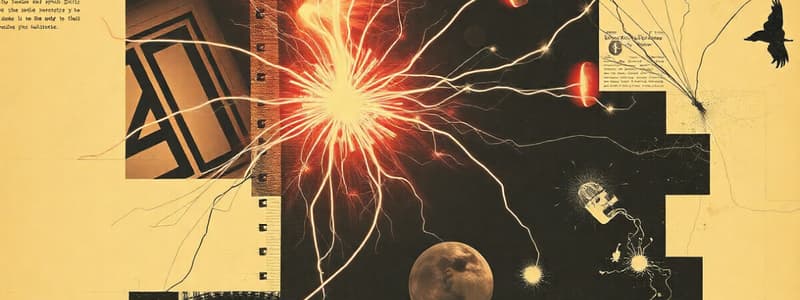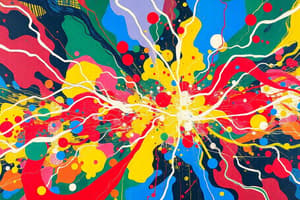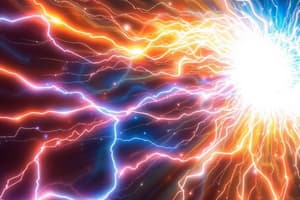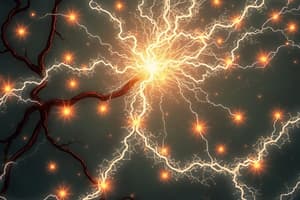Podcast
Questions and Answers
What happens when two rods with similar charges are brought close together?
What happens when two rods with similar charges are brought close together?
- They attract each other.
- They repel each other. (correct)
- They become neutral.
- They discharge electricity.
What occurs when an object is rubbed against another object in terms of electric charges?
What occurs when an object is rubbed against another object in terms of electric charges?
- An electric field is created.
- Only the positive charge transfers.
- One object becomes positively charged and the other negatively charged. (correct)
- Both objects retain their original charges.
Why should experiments involving static electricity be performed in dry weather?
Why should experiments involving static electricity be performed in dry weather?
- Static electricity is more powerful in dry conditions.
- Dry conditions prevent lightning.
- Moist air absorbs the charges of static electricity. (correct)
- Wet weather makes materials less conductive.
What is used as a test to identify an electrically charged object?
What is used as a test to identify an electrically charged object?
What is the result of frictional electricity?
What is the result of frictional electricity?
What does it mean when an atom is described as electrically neutral?
What does it mean when an atom is described as electrically neutral?
What is produced as a result of the interaction between clouds and air during the rainy season?
What is produced as a result of the interaction between clouds and air during the rainy season?
What type of charge is created by friction between two objects?
What type of charge is created by friction between two objects?
What occurs when the negative charge at the base of a cloud exceeds the charge of the ground?
What occurs when the negative charge at the base of a cloud exceeds the charge of the ground?
What is the primary purpose of a lightning conductor?
What is the primary purpose of a lightning conductor?
How does the gold leaf electroscope indicate the presence of an electric charge?
How does the gold leaf electroscope indicate the presence of an electric charge?
What role does the pit filled with coal and salt serve in the lightning conductor system?
What role does the pit filled with coal and salt serve in the lightning conductor system?
What happens to the gold leaves when an uncharged object is brought near the disc of the electroscope?
What happens to the gold leaves when an uncharged object is brought near the disc of the electroscope?
What is the process called when a tall object induces opposite charge due to an electrically charged cloud nearby?
What is the process called when a tall object induces opposite charge due to an electrically charged cloud nearby?
Which component of the lightning conductor is placed at the highest part of a building?
Which component of the lightning conductor is placed at the highest part of a building?
What energy forms are produced during a lightning strike?
What energy forms are produced during a lightning strike?
Flashcards
Electrically Neutral
Electrically Neutral
A state where a substance contains an equal number of positive and negative charges. This results in an overall neutral charge.
Frictional Electricity
Frictional Electricity
The type of electricity generated through friction between objects. This charge is temporary and remains on the object for a short period.
Attraction
Attraction
The force of attraction between two oppositely charged objects.
Repulsion
Repulsion
Signup and view all the flashcards
Charging by Friction
Charging by Friction
Signup and view all the flashcards
Atomic Structure and Charge
Atomic Structure and Charge
Signup and view all the flashcards
Static Electricity
Static Electricity
Signup and view all the flashcards
Lightning
Lightning
Signup and view all the flashcards
Cloud Charge Separation
Cloud Charge Separation
Signup and view all the flashcards
Lightning Discharge
Lightning Discharge
Signup and view all the flashcards
Lightning Conductor
Lightning Conductor
Signup and view all the flashcards
Gold Leaf Electroscope
Gold Leaf Electroscope
Signup and view all the flashcards
Electrostatic Induction
Electrostatic Induction
Signup and view all the flashcards
Discharging
Discharging
Signup and view all the flashcards
Electrical Conductivity
Electrical Conductivity
Signup and view all the flashcards
Study Notes
Electric Charge
- Electric charge is present in all substances, but hidden because equal numbers of opposite charges exist.
- Charges are classified as positive (+) and negative (-) by Benjamin Franklin.
- An object is charged when its positive and negative charges are unbalanced.
Repulsion and Attraction
- Repulsion: Similar charges repel each other.
- Attraction: Opposite charges attract each other.
- These principles can be used to identify charged objects through observation.
Origin of Electric Charge
- All matter is composed of atoms, which contain positive and negative charges.
- Atoms are normally electrically neutral because the positive and negative charges are balanced.
- Disturbance of this balance, such as by friction, leads to a buildup of charge on objects.
- Negative charges move from one object to another during friction, causing one object to become negatively charged and the other positively charged.
Frictional Electricity
- Frictional electricity is produced by rubbing objects together.
- This electricity is static, meaning the charge remains on the object for a short time.
- Damp environments cause static electricity charges to dissipate.
- Charged objects attract uncharged objects due to attraction forces.
- Like charges repel each other.
Atmospheric Electricity
- Lightning:
- Clouds and air rubbing against each other during rainfall generate opposite charges (positive on top, negative on bottom of clouds).
- Large negative charge build-up on cloud bases can induce lightning strikes by attracting positive charge from the ground.
- Lightning is a rapid discharge of charge, producing heat, light, sound, and electric current.
- Lightning Strike:
- Happens when charged clouds pass over a tall object.
- Induced charges cause an attraction allowing charge from the cloud to flow to the building.
Lightning Conductor
- Protects buildings from lightning strikes.
- A copper strip, highest point of the building, connected to an earthing plate (iron plate in a pit with ground materials)
- Allows charge to flow into the ground, preventing damage.
- Protective effect extends to surrounding areas.
Gold Leaf Electroscope
- Simple device for detecting electric charge.
- Consists of a metal rod with gold leaves.
- Leaves repel when a charged object approaches.
- Leaves collapse when the charge is discharged to the ground.
Studying That Suits You
Use AI to generate personalized quizzes and flashcards to suit your learning preferences.




